The Rathva community of Gujarat like most Adivasi communities of India has a revered cultural diversity. Rathva culture is full of colourful mythology, historical lore, music, festivals, rituals and preeminently their art. The Pithora painting form is traditionally performed on walls inside the homes of the Rathvas. It is part of an elaborate ritual performed to complete vows to gain the boon of the chief god of the Rathvas, Baba Pithora. In times of difficulty, Rathva seek the guidance of Badva, the chief priest or shaman of the village. Badva performs readings based on the skills he has acquired through ancestral schooling, and recommends undertaking a vow to paint Pithora in the home in order to gain a boon from Baba Pithora. The person who undertakes the vow is known as Ghardhani, or in simple terms, home owner. As and when the Ghardhani feels that his/her difficulties have reduced, they seek guidance from the Badva and express the desire to undertake the painting of Pithora in their homes. The Ghardhani and Badva invite a Lakhara (individual who paints Pithora) of repute in the community. The Lakhara then visits and discusses with Ghardhani and Badva the details of the vow and thereafter prepares to create the Pithora Painting. The completion of the painting would signify the end of the ritual and fulfillment of the vow, and is followed by a village dinner.

In ancient times when Rathva homes were made of bamboo and grass, the Pithora used to be painted using natural colours mixed with Mahuda alcohol and cow’s milk. The wall to be painted would be tempered with ‘Pandu Maati’ or white clay. The Pithora is traditionally painted on three walls usually in the ‘Osari’ or porch of main house. The traditional size of a Pithora painting is 11 x 8 feet. The background is usually white, with expressive vibrant colours used for the motifs.
Motifs in Pithora Painting
The motifs in the Pithora painting represent the mythology of the community along with exclusive depiction of the most essential aspects of the daily life. The protagonists of the entire painting are horses of the gods and goddesses and ancestors in vibrant colours. The painting is adorned with motifs from nature, daily human activities, animals, farming, trade, important members of the community, along with several new elements, which symbolically represent modernity. The chief deities that appear in the Pithora painting are Baba Ganeh, Baba Ind, Baba Pithora, Pithori Rani, Rani Kajal, Baar Matha no Dhani Raja Bhoj, Abho KunbiNakti Bhuten, Lakhari & Jokhari and Purvaj na Panch Ghoda.
Baba Ganeh is the first motif, drawn customarily on the right side of the painting. He is usually painted in blue and carries a ‘hukka’. Important festivals and occasions commence with the worship of Baba Ganeh among the Rathva. Rathvas also worship Baba Ganeh as Ganpati Dada who always has an elephant’s trunk. In the Pithora painting, Baba Ganeh is characterized as a father figure.
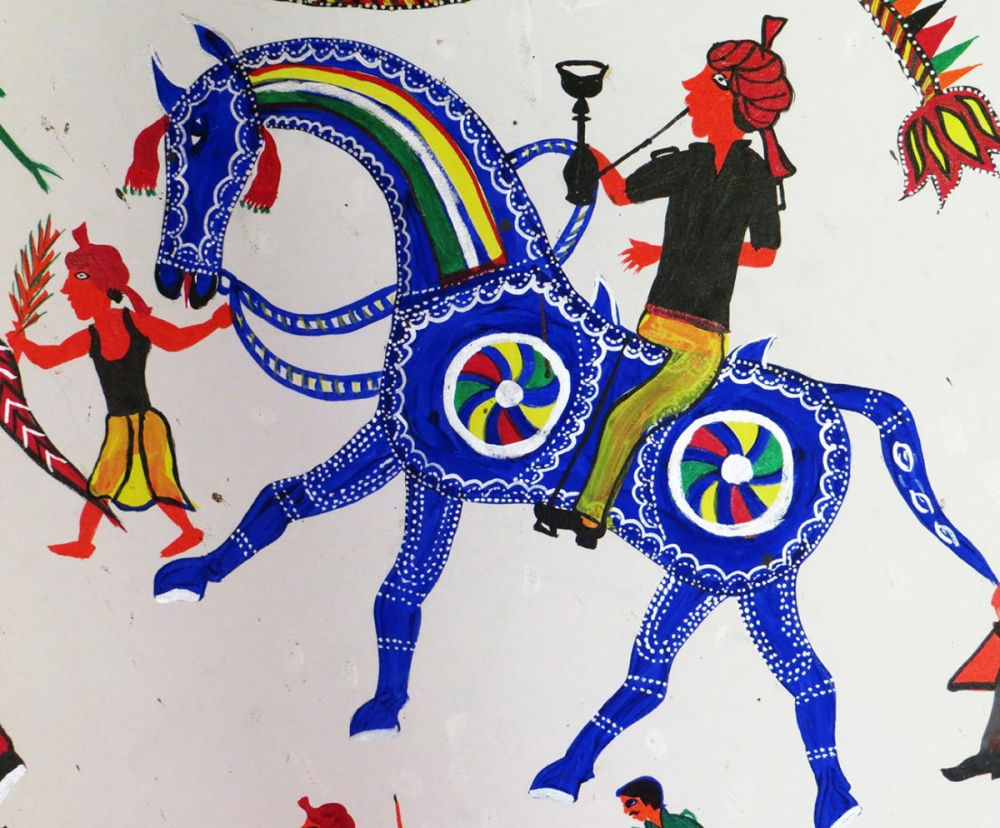
A folk song first narrates the story behind the worship of Baba Ganeh. Once upon a time, Baba Ind called for a grand congregation of all gods in his court. En route to the court, the chariot of the gods got stuck. Despite all efforts, the chariot couldn't be moved. The gods concluded that Baba Ganeh was behind this event. They called upon him for help and thereafter invited him to Baba Ind’s court. From that day on, it is mandated that before every ceremony Baba Ganeh’s name will be taken.
Baba Ind is the lord of rain and protector of all animals. He is the brother of Rani Kajal, Rani Kali Koyal and maternal uncle of Baba Pithora. In the Pithora painting, he is portrayed as strong, young and brave with a parrot in his hand.
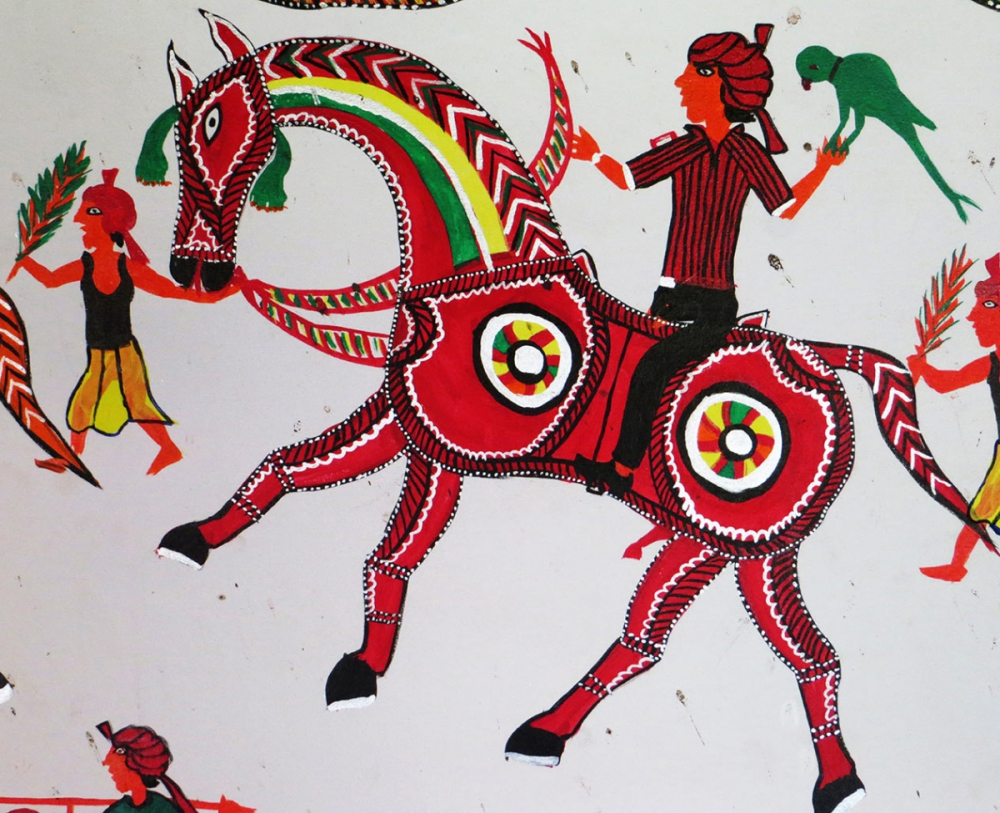
The Rathvas undertake a vow to Baba Ind to seek a boon for better health of family members and livestock, good yield of crops, and most importantly a boon for a child. In Chhota Udepur and Panchmahal districts of Gujarat, every five years the celebration of a festival of Baba Ind takes place in several villages, where traditional songs are sung, dances are performed to the music of the dhol and pehi, while Badva performs rituals.
Baba Pithora is the primary god of the Rathva. He is the son of Rani Kali Koyal and Kandu Raja. Rani Kajal brought him up. In his childhood, he hid himself in the wall and selected the wall as his seat, which is why his painting is installed on the wall.
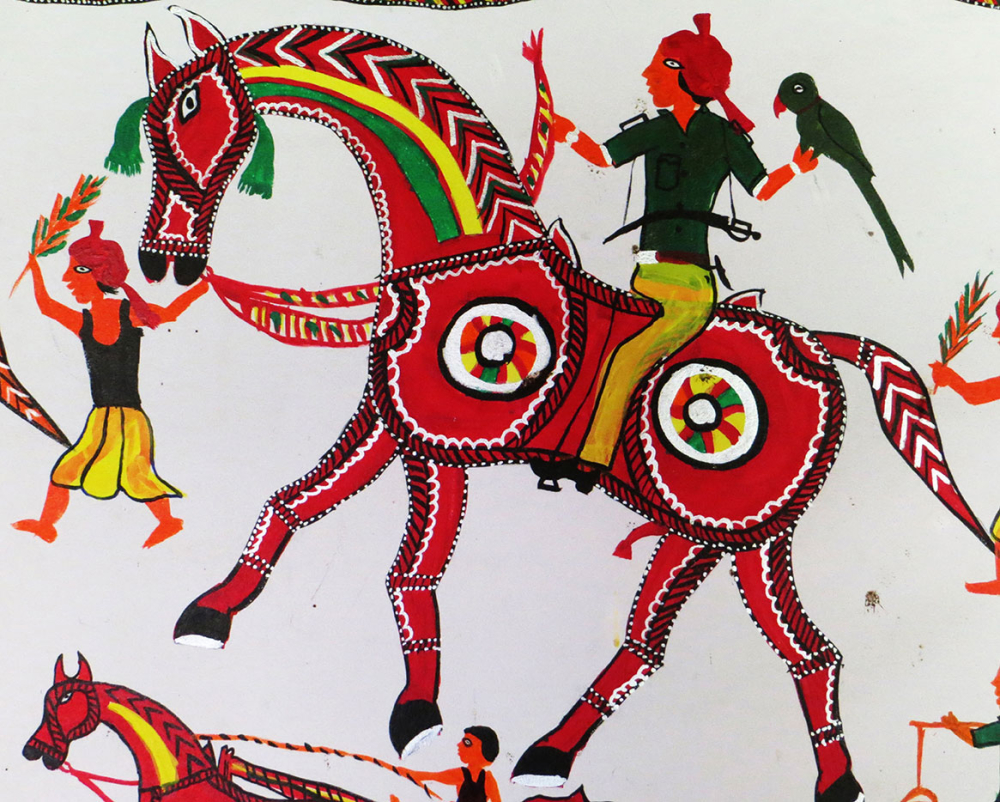
In Pithora painting, he is portrayed as young, strong and manly with a parrot and a flower is his hand. Baba Pithora for the Rathva is a conglomeration of different gods, animals, nature, and all creations of the universe.
Pithori Rani is the wife of Baba Pithora and daughter of Abho Kunbi.
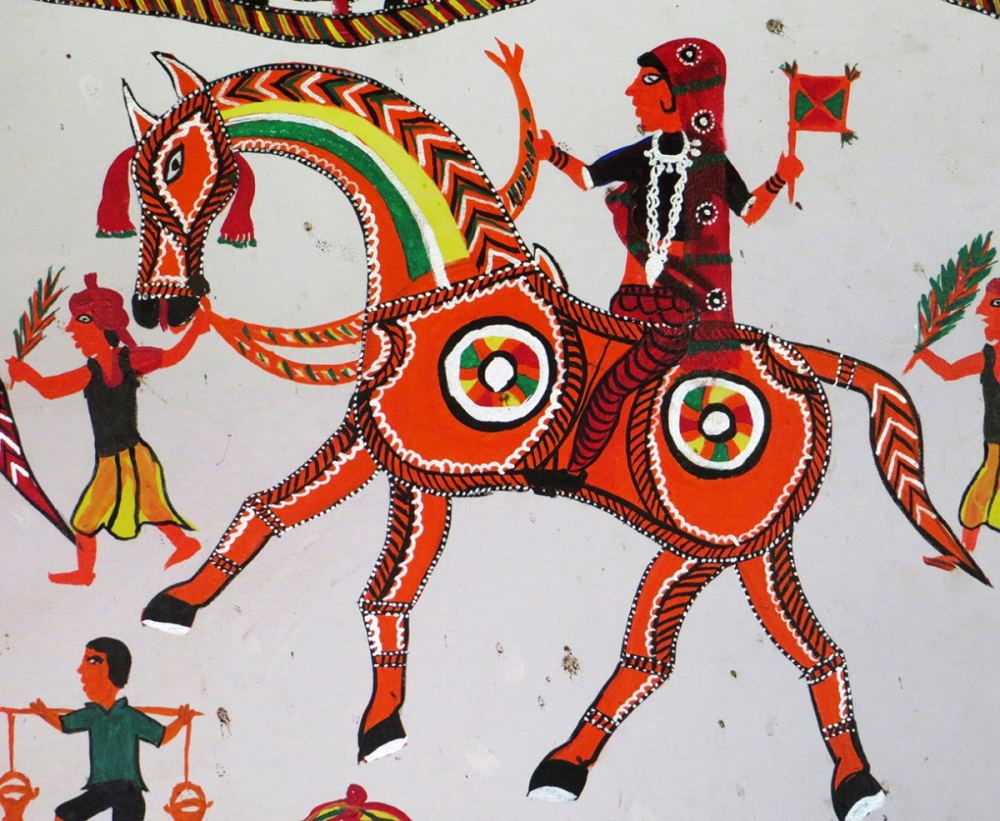
In the Pithora painting, she carries a fan in her hand. She is worshipped during times of erratic monsoons. In the painting, she is portrayed as celestial and a devoted wife ready to aid her husband in all his endeavors.
Rani Kajal is the sister of Baba Ind and foster mother of Baba Pithora. She rescued Pithora as a child from the sea and looked after him. In the Pithora painting, she is painted on the left side and has a very important status as a mother.
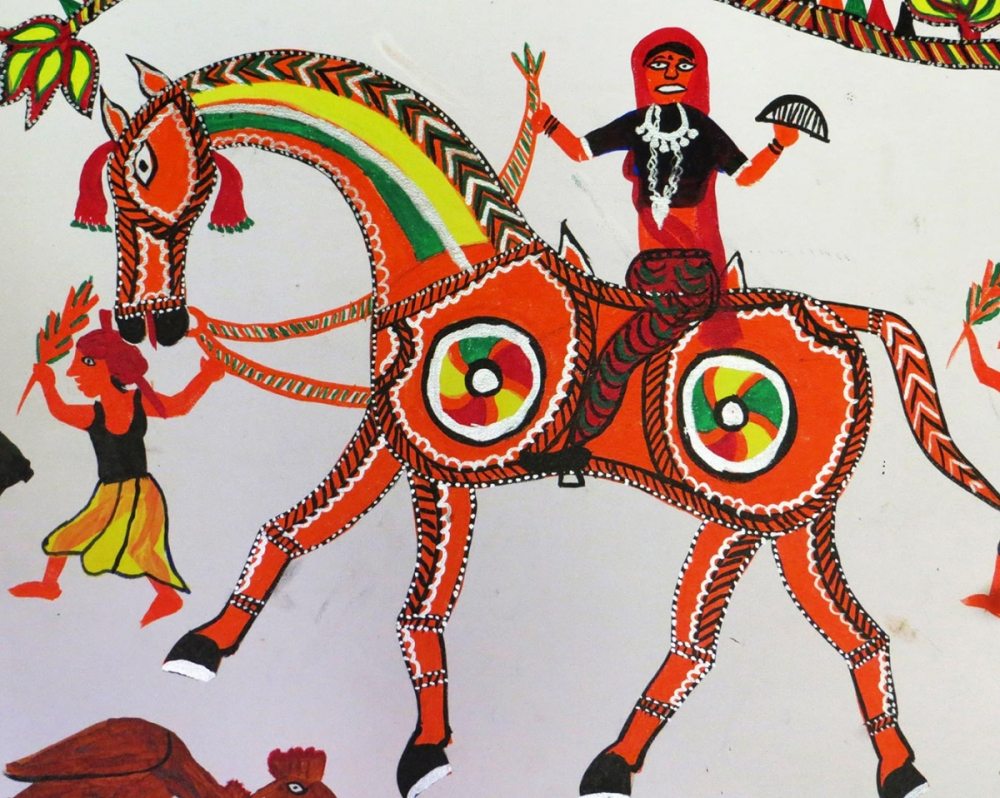
She is also worshipped as Kuldevi or the goddess of the clan. She carries a comb in her hand, which symbolizes her ability to cleanse the world. The temple of Rani Kajal is on a mountain near Mathvad village near river Narmada along the borders of Gujarat and Madhya Pradesh.
Baar Matha no Dhani ('The Enlightened One with 12 Heads') protects the Adivasi from all 12 directions. He possesses knowledge of the universe, and protects living organisms and nature, and is a very brave deity.
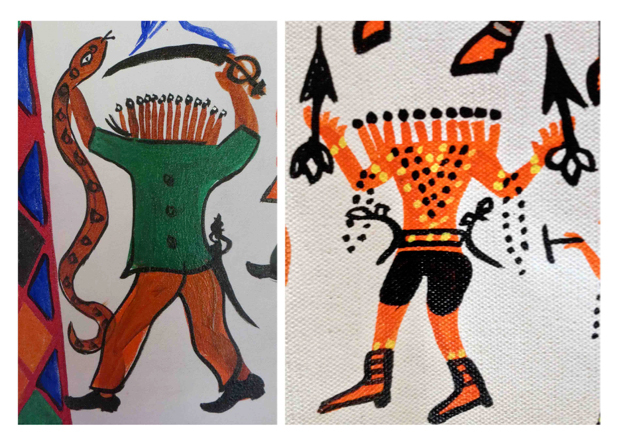
In Pithora painting, he is portrayed holding Nagdevta ('Lord of Snakes') in his hands along with swords. Baar Matha no Dhani offered protection to Rani Kali Koyal, when she was in labour, which is why he is an essential and recurring character in most of the Pithora paintings. Several scholars compare this Rathva deity with Ravana from Ramayana, but the Rathva claim that they are not the same and are decisively different.
Raja Bhoj and his elephant: Raja Bhoj was a great, rich and generous king who was very benevolent to his subjects. He would organize a grand celebration of the Dussehra festival, and would himself join the procession on his elephant.
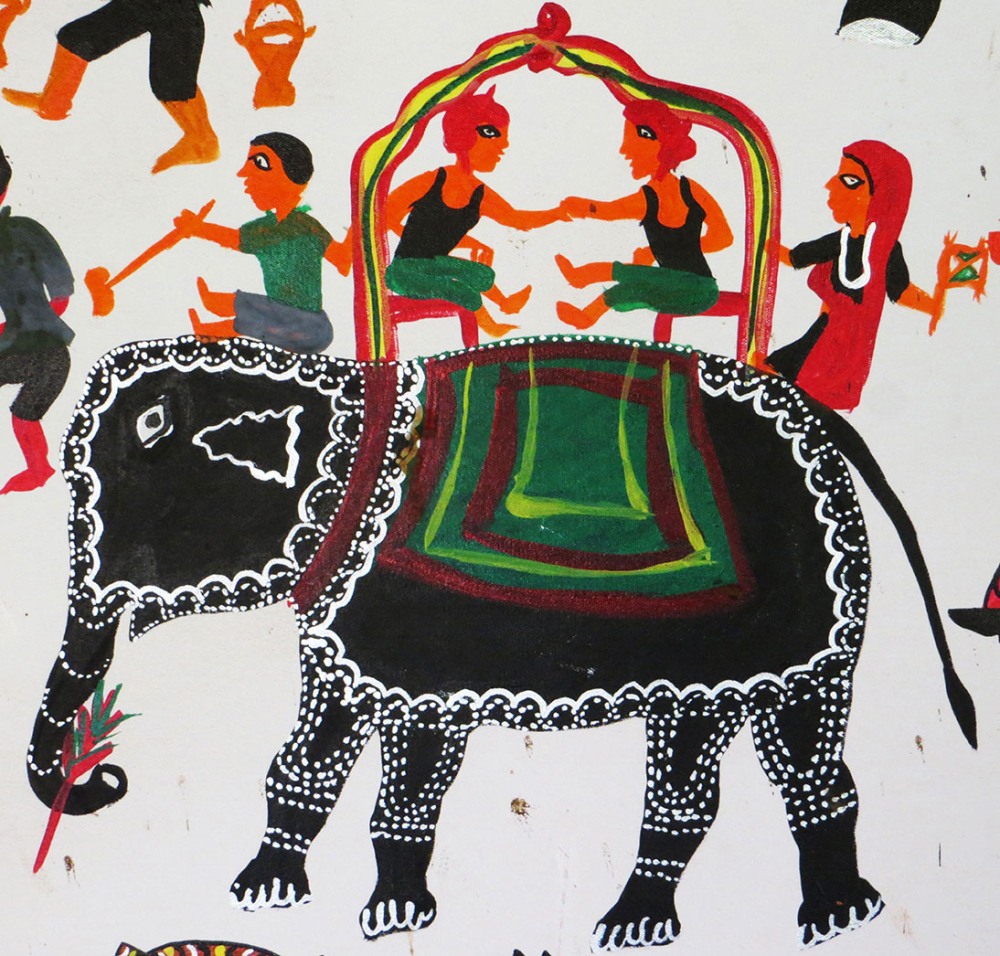
In the Pithora painting, he is always portrayed riding an elephant with a huge Ambadi or an umbrella. Raja Bhoj looks after agriculture, livestock and rain on earth, which is why he is also known as Raja Bavaji.
Abho Kunbi and Mathari (the farming couple) are creators of the art of farming. They are also credited with teaching this art to the human race. They taught them how to sow seeds, prepare fields for sowing, till farms, harvesting, and all associated activities related to farming and agriculture. Pithori Rani, the wife of Baba Pithora is the daughter of Abho Kunbi and Mathari.
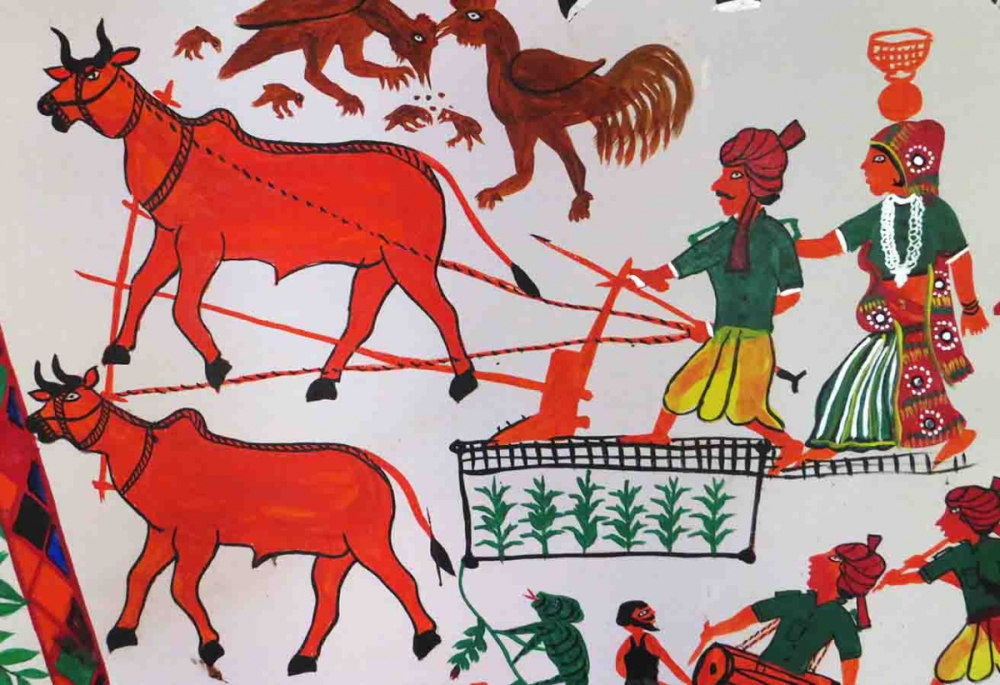
Nakti Bhuten is portrayed on a white horse, placed on the left of the Pithora painting. He is protector of the household and is very different from other gods and goddesses. His appearance is very fierce and he is a very powerful deity.
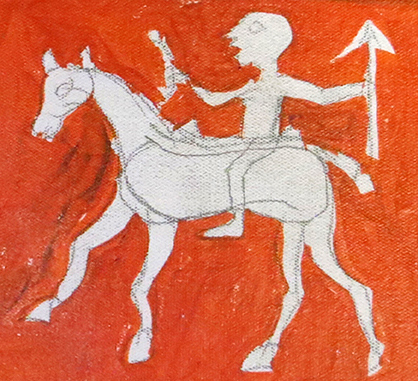
Lakhari and Jokhari (authors of future) according to the traditional beliefs, on the fifth or sixth day after a child's birth, Lakhari and Jokhari visit their homes to write their future. It is said whatever predictions are made on this occasion never fail to materialize.
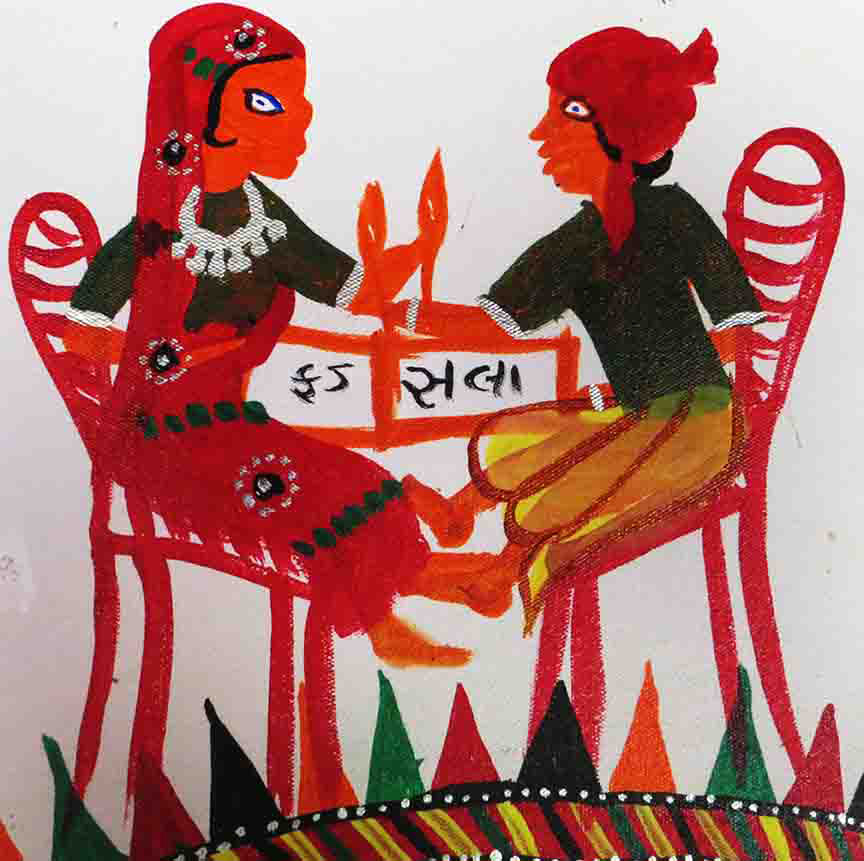
In the story of Baba Pithora, Lakhari and Jokhari wrote about his future on the wall, the chosen seat of Baba Pithora. It is since then the tradition of painting Pithora on the wall has begun, and Lakhari and Jokhari are portrayed in the painting.
Purvaj na Panch Ghoda (five horses of ancestors) in memory of their ancestors, the Rathva places intricately carved wooden horses either in the farms or in their homes. They recognize these artifacts as Khatrij Dev. The Khatrij Dev is the first deity to be worshipped on all important occasions and festivals. Every year, each family organizes a village feast in memory of their ancestors. In the Pithora painting, Purvaj na Panch Ghoda are a symbolic representation of the ancestors of the community.

Motifs of Nature: The sky, gods, earth, human beings, vegetation, animals, birds and all living creatures of the universe are comprehensively incorporated in the Pithora painting of the Rathva community. They exhibit a prudent understanding of the universe through the medium of their painting. The recurring motifs related to elements of nature are the sun, moon, and trees that are considered holy by the Rathva.
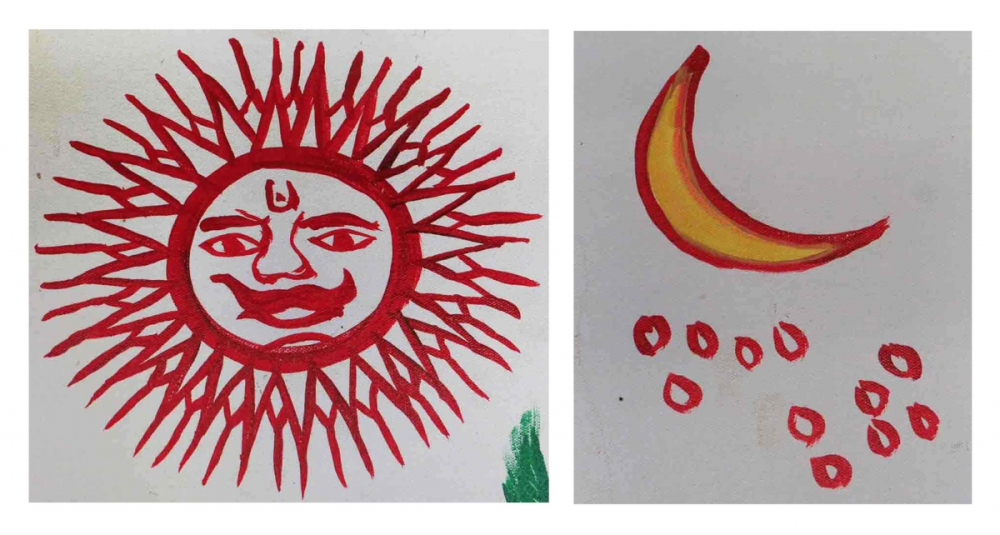
The sun is a living god for all living beings of the universe. He is known as Huriyadev by the Rathva and is considered the universal guardian. The moon is considered a god and is also known as Handaryo Dev by the Rathva community. They also recognize eclipses and signal these through their famous kikiyari howl.
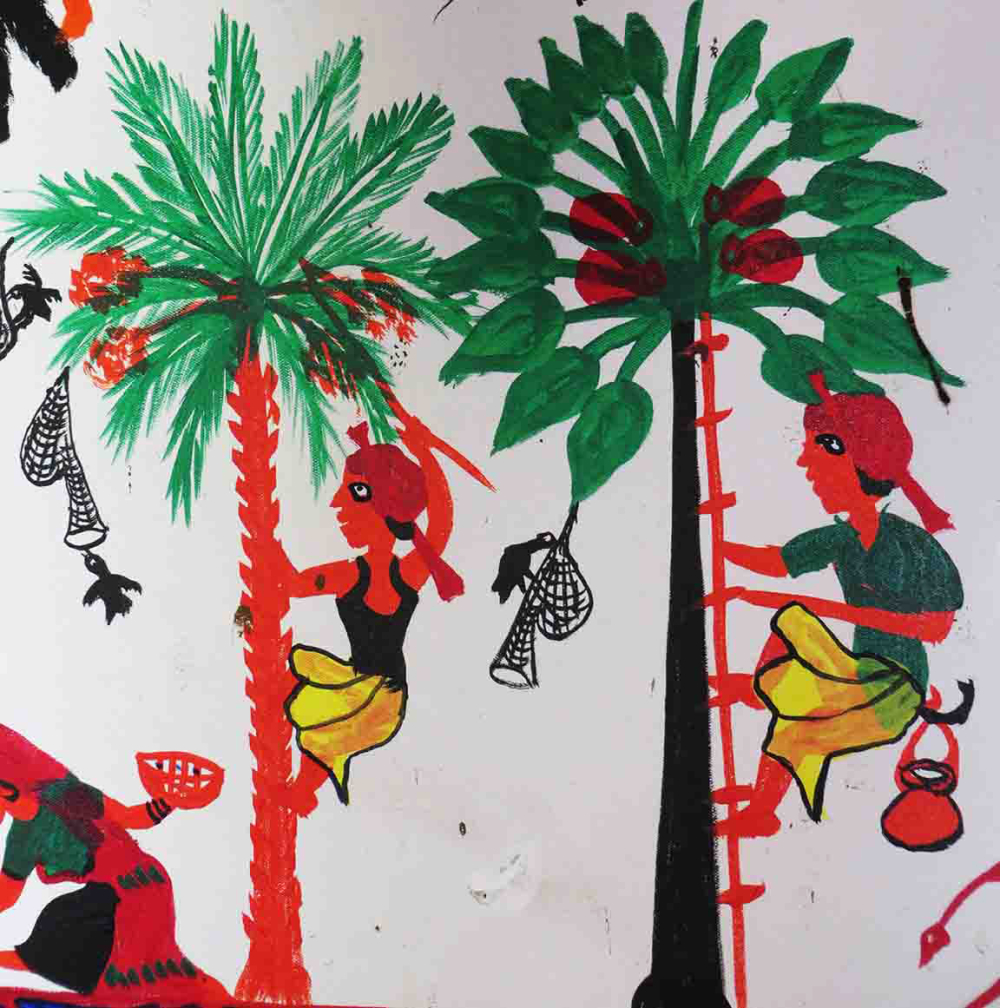
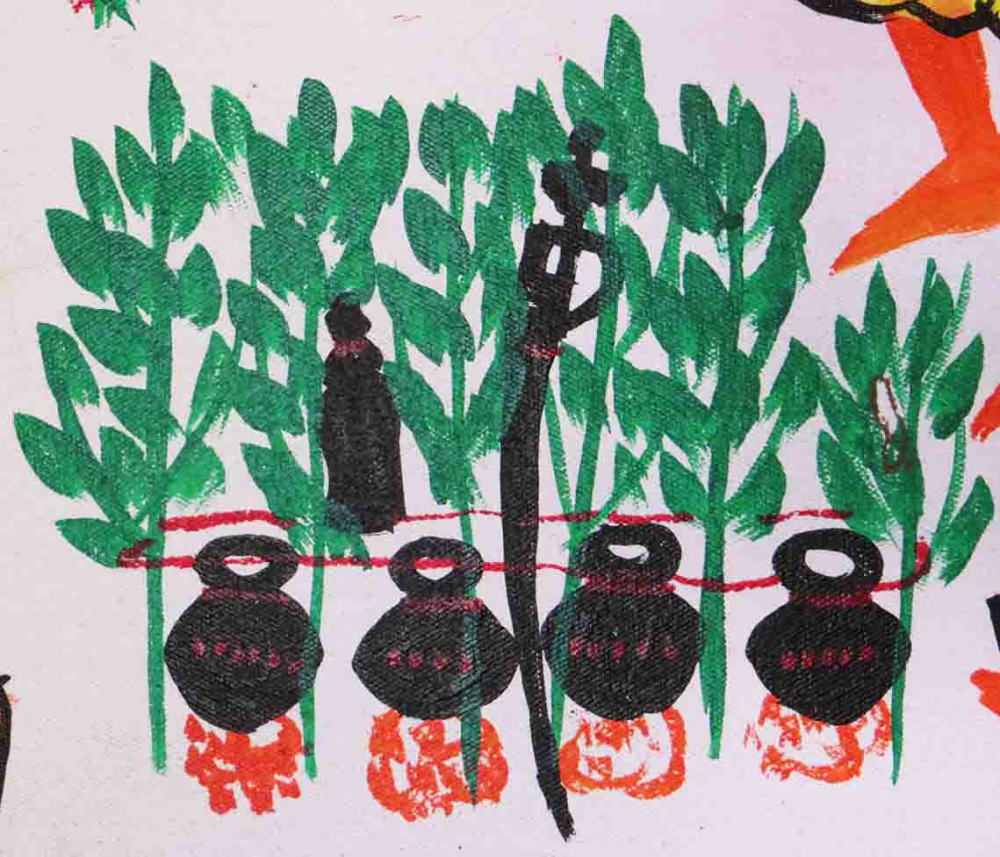
The branches of kadam tree are important in the ritual of the Pithora painting. The family of Ghardhani takes out a procession to the nearest kadam tree to gather its branches; the dhol and pehi are played in the background. The Tad and Khajoori trees can be seen extensively in Adivasi areas. The tad tree yields a sweet fruit called tadkali which is used to make nira, which is a very healthy and medicinal drink and is the main ingredient for making the alcohol drink called tadi. The leaves of the tad tree were used for making roofs and walls of Rathva homes and used as a medium to write on. Similarly, the khajoori tree has many uses apart from its fruit khajoor (dates).
Motifs related to animals: The Adivasi have a vast tradition exemplifying their unique closeness to nature, living in harmony with the animal kingdom. A wide range of animals is portrayed in the Pithora painting of the Rathvas.
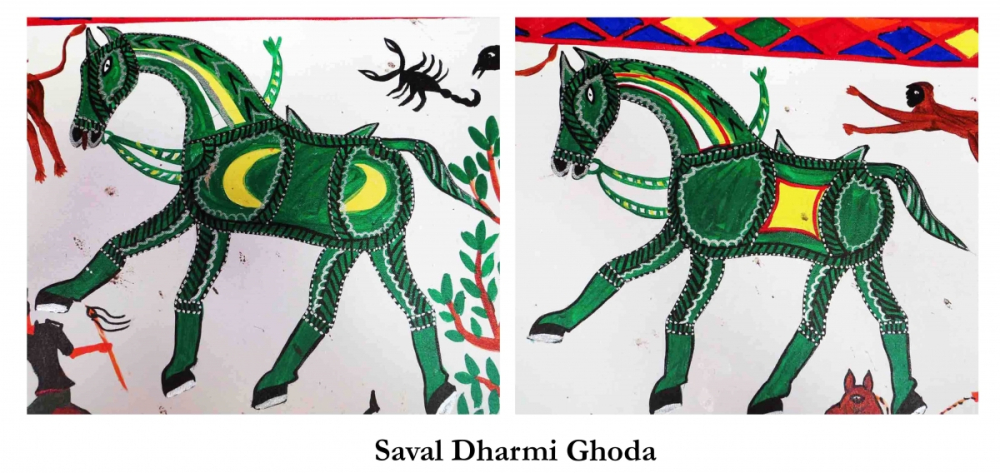
The Saval Dharmi Ghoda (horses of civic righteousness) are an important element of the Pithora painting. In the cultural tradition of the Adivasi, there are several mentions of the great exploits of heroes, and Saval Dharmi Ghoda represents these heroes in the Pithora paintings.
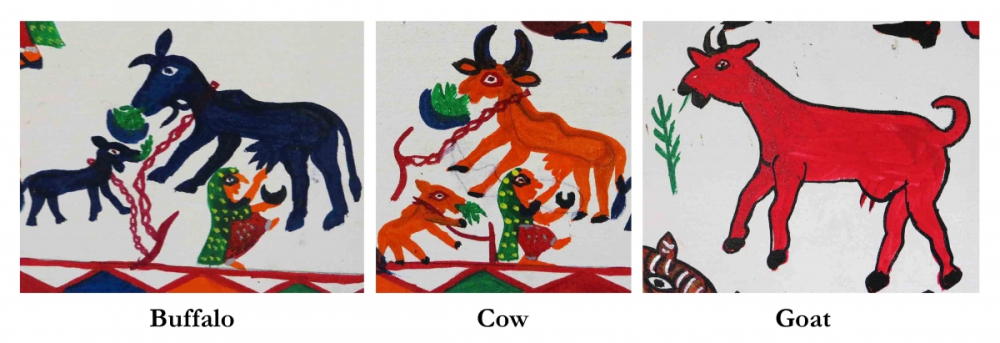
The Rathvas consider the buffalo and cow holy animals. Their produce—milk, buttermilk, dung, curd etc.—are extremely important in the lives of the Rathva. Cowdung is also utilized in several ceremonies of the Baba Pithora ritual. The Rathva’s believe that the goat was the first animal to be domesticated by their ancestors. The working class of the Adivasi community often rear goats to meet their milking needs. The goat is an important part of the Baba Pithora ritual, since it is a common choice for animal sacrifice.

Lion is the symbol of strength and religion; he is also the most powerful animal and a vehicle of several gods. Tiger is portrayed as the protector in the painting. Lion and tiger are portrayed atop the celestial gate, as they protect the inhabitants. The Rathva, Nayak and Tadvi communities celebrate a ritual to entice the rain, when people in the costume of camels go out in procession. This ritual is called untadi kadvi ('bring out the camel').

Deer is considered a symbol of beauty, naïvete, honesty and a lover of music by the Rathva. In Pithora paintings, sometime a two-headed deer is also portrayed. Chicken is another common choice for animal sacrifice. The peacock features in the Pithora paintings as a vehicle of the goddess.
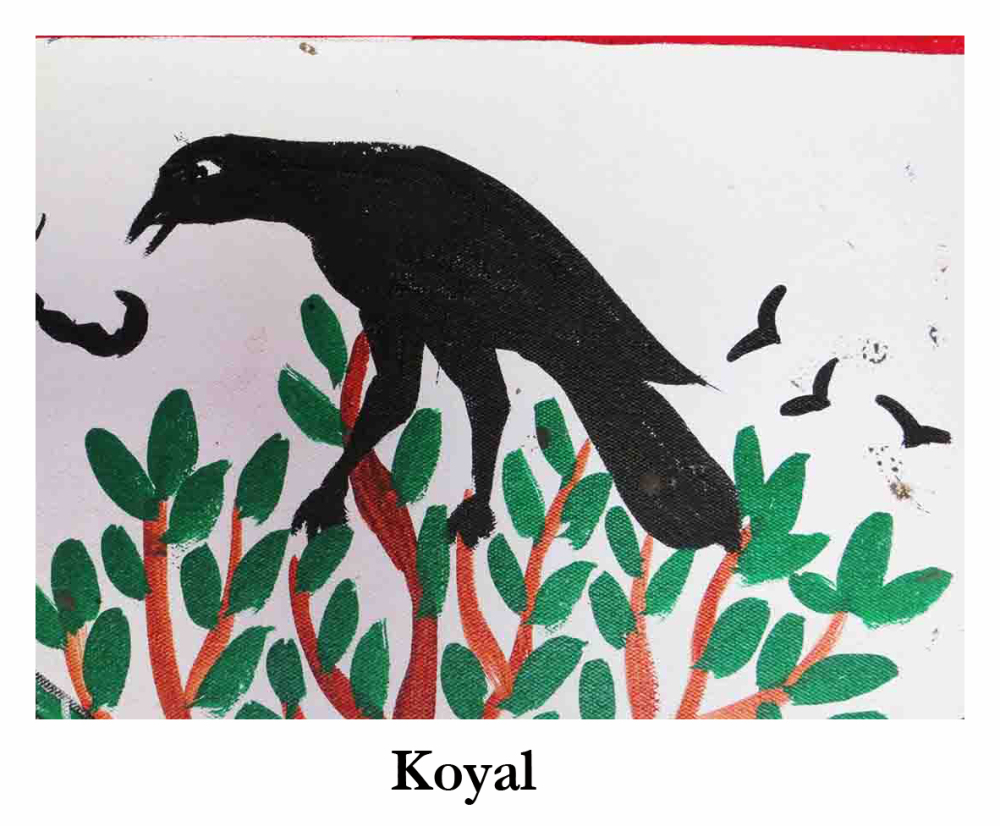
The Koyal bird features in the Pithora painting as symbolic representation of Rani Kali Koyal, the birth mother of Baba Pithora and the most beautiful sister of Baba Ind.
Mamo Karodiyo is considered the maternal uncle of Baba Pithora. Once upon a time, when Baba Pithora was on a quest to meet Baba Ind and needed to climb to heaven, he sought the aid of Mama Karodiyo who helped him climb up to heaven on his web. This is how Mamo Karodiyo found his way into Pithora painting.
Motifs related to human activities: Pithora painting shows several human characters and scenes of daily activities: the Bhuva conducting ceremonies, the village tradesman, the hunter, policeman, village postman, alcohol making, buttermilk churning, women drawing water from wells or hand pumps, men and women dancing.
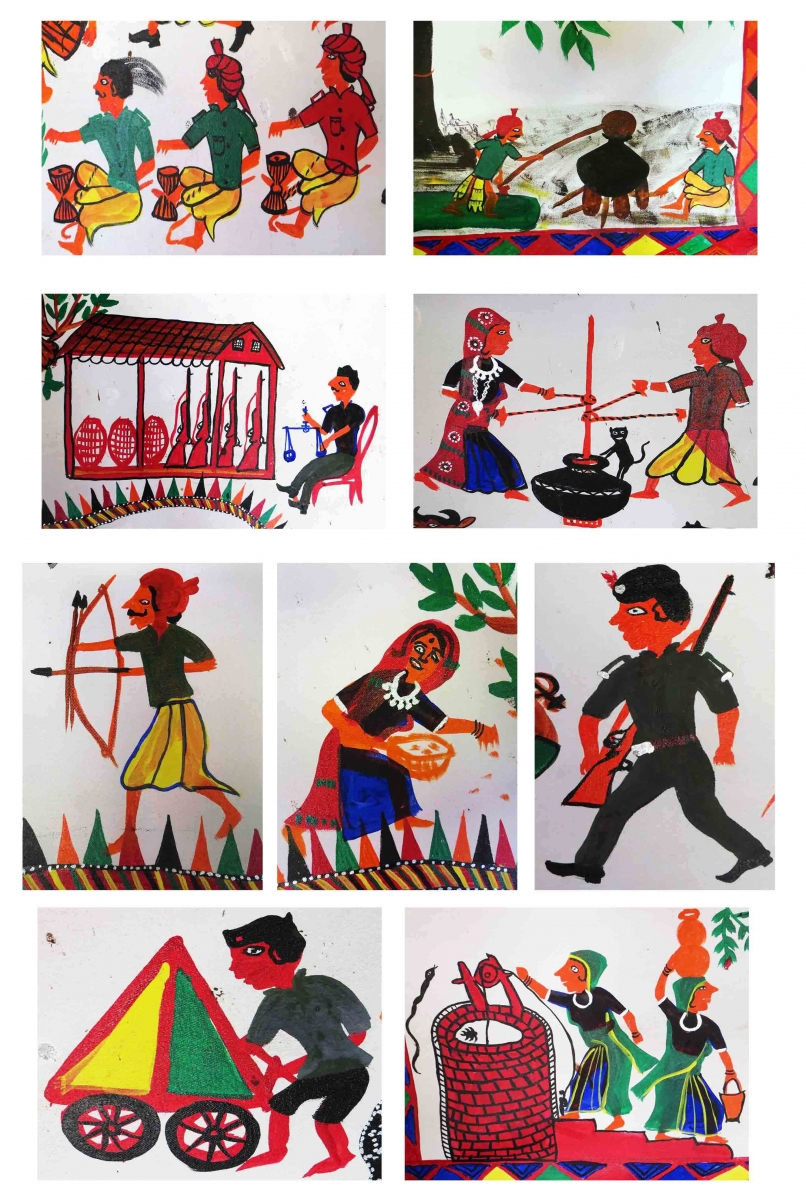
Ashad has two interpretations in the Pithora painting of the Rathva. The first states that it is a canopy for the procession of gods and goddesses while the other interprets it as a symbolic border of a village.

Pithora painting also depicts instruments of daily life.
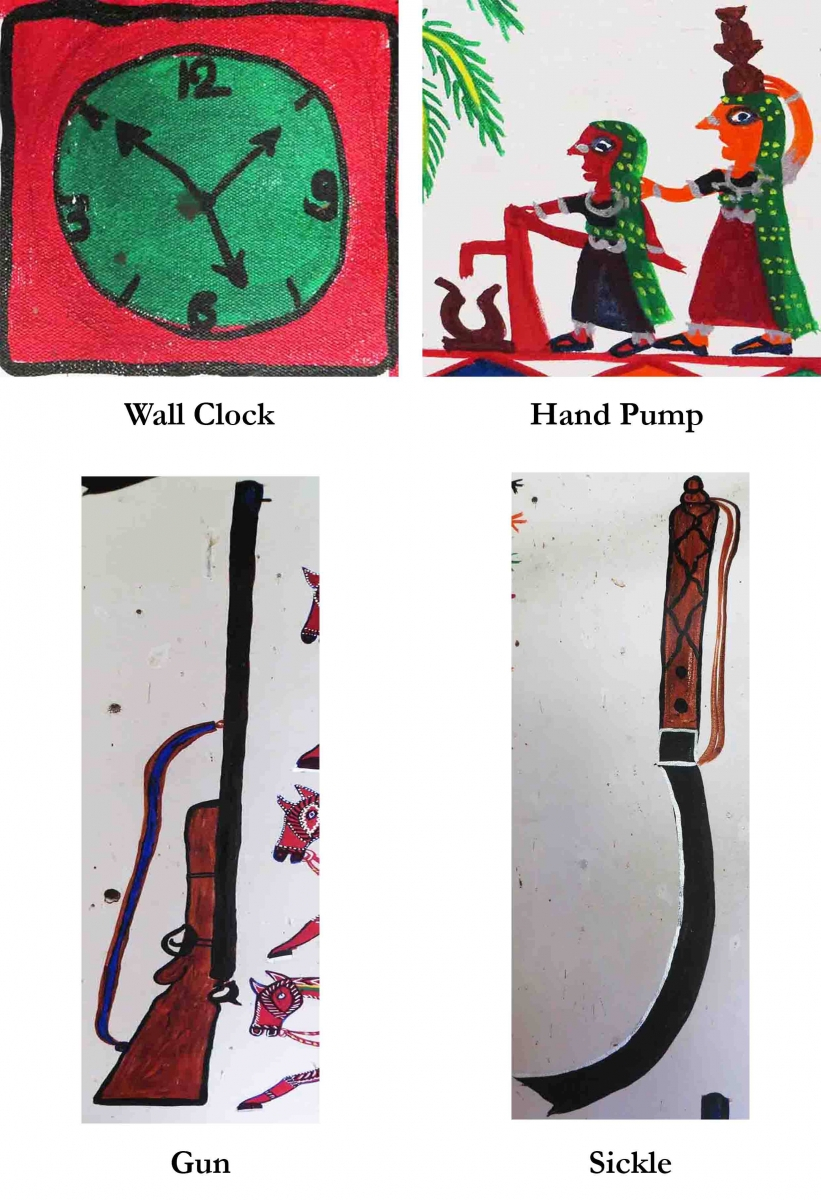
Conclusion
A Pithora painting can have up to 165 different types of motif depicted. Each motif is associated with an extensive literature signifying its importance within the painting. Each character is presented as a protagonist in an important event of the vast mythological epic of Baba Pithora. The motifs reveal the manner in which the Adivasi view their world. They represent the significance of elements of nature, flora, fauna and celestial elements, and their influence on their lives.
Bibliography
Rathva, N. and Rathva V. 2016. ‘Bhartiya Aadim Chitrakala: Rathva Samajma Babo Pithoro’. Vadodara: Bhasha Research and Publication Centre.












